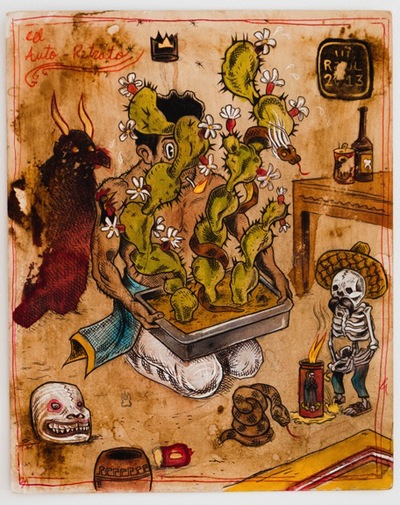Bedlam…
Raul Gonzalez III
Los Nuevos Guerreros
July 17- August 31, 2013
Carroll and Sons
450 Harrison Avenue
Boston
carrollandsons.net
—
By Robert Moeller
The Mexican border town of Ciudad Juarez is a killing ground. In the five years leading up to 2011 roughly 9,000 people were murdered there. This includes the unsolved slayings of several hundred women, many of whom came to Juarez to work in the maquiladoras, which are large assembly plants situated near the border with the United States. The products made in these factories are not the only things exported from Juarez, as it is also a center of the Mexican drug trade and a vital transit hub for people seeking to enter the United States illegally. At times, raging gun battles between rival drug cartels have crippled the city and troops have been called in to restore a semblance of order. Over the last several years, things have improved and the violence has decreased, but Juarez, by any standard, remains a very dangerous place.
Raul Gonzalez III, who grew up in Juarez before moving to Boston, looks back at the brutality of his birthplace with a controlled violence of his own. His new work, a hundred and one drawings, based on a book called 101 Samurai, is a riotous explosion of cultural hellfire. The exhibition, called Los Nuevos Guerreros (The New Warriors) at Carroll & Sons in Boston, with its depictions of drug dealers, assassins, boxers, and narco-saints, literally overflows with a vicious compassion that informs this motley assemblage of characters, even the worst of them, with a dignity not perhaps afforded them in their brief, calamitous lives.

Raul Gonzalez III, El Auto-Retrato, 2013. Mixed media on paper. 12 x 9.5”
The work, no doubt a reaction to violence sweeping across Mexico, and its many, many victims, has a cartooned elegance despite the roughness of the subject matter and the earthiness of Gonzalez’s technique. Coffee stains and Gonzalez’s son’s doodles add a patina to the drawings, making them look like artifacts. Indeed, what drives him most, it seems, is a documentary impulse. This is foremost an intellectual exercise, a cataloging of suffering and disenfranchisement. Despite the humor present in many of the drawings, a keen sadness pervades the subtext of the work. This tension between the humors adapted as a protective coating and the extremes of violence present in everyday life pulses through these drawings. At root, Gonzalez is a visual historian, a storyteller, bawdy and unvarnished. He explores a moment in time, beyond the control of ordinary people, where extraordinary things are happening.
The visual strategies that Gonzalez evokes range evenly across a range of genres. Elements from the samurai book that inspired him are superimposed, and then vanish in a cascade of sweeping lines and gestures. There is gaudiness present, too, almost a tabloid-like luridness that pitches the violence to willing consumers who are both victims and a captive audience.

Raul Gonzalez III, Las Trensas, 2012. Mixed media on paper. 30 x 22.5”
Oddly enough, many of the problems facing Juarez were created by the North American Free Trade Agreement, which included the cancellation of Article 27 of Mexico’s constitution, protecting communal land holdings from privatization. Upon ratification of the law in 1994 the Zapatistas declared war on the Mexican state. The agreement’s goal was to loosen trade restrictions between the United States, Canada, and Mexico. The realities on the ground in Mexico had unintended consequences, including population shifts that flooded cities like Juarez with people looking for work and an overwhelming overload of city services and infrastructure.
There is a Hogarthian element to Gonzalez’s work as well. One is reminded of the last scene in The Rake’s Progress and Tom Rakewell’s final descent into madness at Bethlehem Hospital (Bedlam), London’s infamous mental asylum—not stylistically, of course, but rather morally. This spiraling down, or even just spinning out of control, animates Gonzalez’s work with a feverish awareness of circumstances so perversely gone wrong that they almost defy description.

Raul Gonzalez III, El Ano De La Arena, 2011. Mixed media on paper. 22 x 17”
What’s present, too, is the always-looming shadow of the United States. While there is nothing explicitly political in Gonzalez’s work you would be hard pressed not to pull certain conclusions from the drawings. Of course, not all of the chaos in Mexico can be attributed to its northern neighbor, but there is a prevailing sense that Gonzalez, at least, lays partial blame (and rightly so), on the sometimes mockingly racist policies emanating from Washington. No doubt, the recent immigration debate in Congress, fraught with moments of cringe-worthy stereotyping, and worse, hasn’t escaped the artist’s attention. Just recently, Steve King, a Republican from Iowa disputed the notion that a lot of unauthorized immigrants are strong students: “It’s true in some cases,” he said, “But for every one who is a valedictorian, there’s another 100 out there that weigh 130 pounds and they have calves the size of cantaloupes because they’re hauling 75 pounds of marijuana across the desert.”
Rarely does a body of work delve so completely into a society’s dysfunction and emerge so unsullied. The humanistic impulse that Gonzalez exhibits is in striking counterpoint to what he depicts, yet perfectly in sync with it. He knows and has experienced what he draws. Or he can extrapolate the exaggerations present in the work into hyped-up representations of the very, very, real mythologies of violence all too present in Mexican society.
